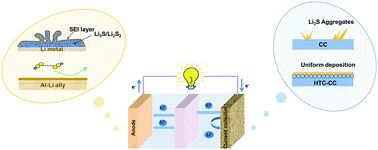当前位置:
X-MOL 学术
›
Energy Environ. Sci.
›
论文详情
Our official English website, www.x-mol.net, welcomes your feedback! (Note: you will need to create a separate account there.)
Towards a reliable Li-metal-free LiNO3-free Li-ion polysulphide full cell via parallel interface engineering†
Energy & Environmental Science ( IF 32.5 ) Pub Date : 2018-06-16 00:00:00 , DOI: 10.1039/c8ee00937f Ju Sun 1, 2, 3, 4 , Jiaxing Liang 1, 2, 3, 4 , Junnan Liu 2, 3, 4, 5 , Wenyan Shi 1, 2, 3, 4 , Neeraj Sharma 2, 3, 4, 5 , Wei Lv 6, 7, 8, 9, 10 , Ruitao Lv 8, 10, 11, 12, 13 , Quan-Hong Yang 14, 15, 16, 17, 18 , Rose Amal 1, 2, 3, 4 , Da-Wei Wang 1, 2, 3, 4
Energy & Environmental Science ( IF 32.5 ) Pub Date : 2018-06-16 00:00:00 , DOI: 10.1039/c8ee00937f Ju Sun 1, 2, 3, 4 , Jiaxing Liang 1, 2, 3, 4 , Junnan Liu 2, 3, 4, 5 , Wenyan Shi 1, 2, 3, 4 , Neeraj Sharma 2, 3, 4, 5 , Wei Lv 6, 7, 8, 9, 10 , Ruitao Lv 8, 10, 11, 12, 13 , Quan-Hong Yang 14, 15, 16, 17, 18 , Rose Amal 1, 2, 3, 4 , Da-Wei Wang 1, 2, 3, 4
Affiliation

|
There has been intensive concentration and effort on addressing the notorious challenges of Li–S batteries with respect to polysulphide utilization and lithium dendrite inhibition. However, the search for and optimisation of a Li-metal-free full cell design remain relatively premature in terms of the generic synchronous approach to improve the anode/cathode stability while balancing the anode/cathode capacity. We hereby report a parallel interface engineering (PIE) strategy to enhance the full-cell performance of the Li-ion polysulphide battery. Very importantly, this PIE strategy allows the use of a Li-metal-free anode and a LiNO3-free electrolyte. The cell-level improvement is attributable to more efficient and uniform lithium sulphide deposition on the chemically uniform surfaces of the carbon cathode and suppressed growth of dendritic species on the Li–Al alloy anode with an implantable solid–electrolyte interphase. Quantitative electrochemical alloying for anode fabrication allows increased lithium utilization relative to the total anode capacity. The PIE strategy represents a facile approach to address the troublesome issues of Li–S batteries at the full cell level.
中文翻译:

通过并行接口工程 实现可靠的无锂金属,无LiNO 3的锂离子多硫化物全电池†
为了解决Li-S电池在多硫化物利用和锂枝晶抑制方面的臭名昭著的挑战,人们进行了集中精力和努力。然而,就一般的同步方法而言,寻找和优化无锂金属全电池设计在改善阳极/阴极稳定性同时平衡阳极/阴极容量方面还为时过早。我们在此报告一种并行接口工程(PIE)策略,以增强锂离子多硫化物电池的全电池性能。非常重要的是,这种PIE策略允许使用无锂金属的阳极和LiNO 3不含电解质。电池水平的提高归因于更有效,更均匀的硫化锂在碳阴极化学均匀表面上的沉积,并抑制了具有可植入固体-电解质界面的Li-Al合金阳极上树枝状晶体的生长。用于阳极制造的定量电化学合金化可提高相对于总阳极容量的锂利用率。PIE策略代表了一种在整个电池单元级别解决锂电池问题的简便方法。
更新日期:2018-06-16
中文翻译:

通过并行接口工程 实现可靠的无锂金属,无LiNO 3的锂离子多硫化物全电池†
为了解决Li-S电池在多硫化物利用和锂枝晶抑制方面的臭名昭著的挑战,人们进行了集中精力和努力。然而,就一般的同步方法而言,寻找和优化无锂金属全电池设计在改善阳极/阴极稳定性同时平衡阳极/阴极容量方面还为时过早。我们在此报告一种并行接口工程(PIE)策略,以增强锂离子多硫化物电池的全电池性能。非常重要的是,这种PIE策略允许使用无锂金属的阳极和LiNO 3不含电解质。电池水平的提高归因于更有效,更均匀的硫化锂在碳阴极化学均匀表面上的沉积,并抑制了具有可植入固体-电解质界面的Li-Al合金阳极上树枝状晶体的生长。用于阳极制造的定量电化学合金化可提高相对于总阳极容量的锂利用率。PIE策略代表了一种在整个电池单元级别解决锂电池问题的简便方法。



























 京公网安备 11010802027423号
京公网安备 11010802027423号